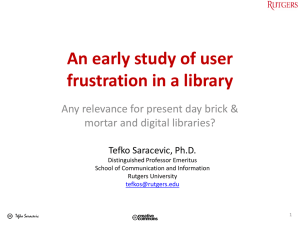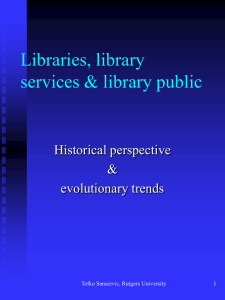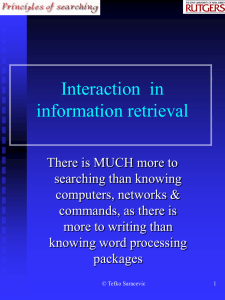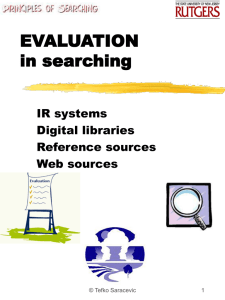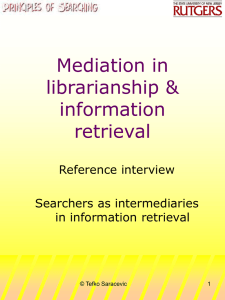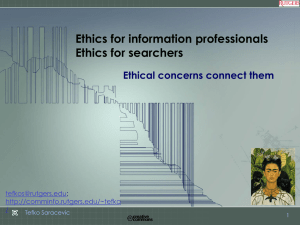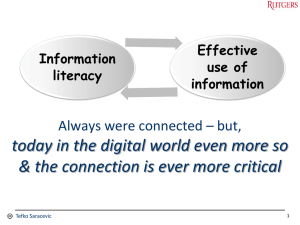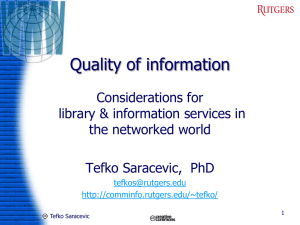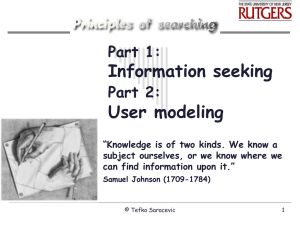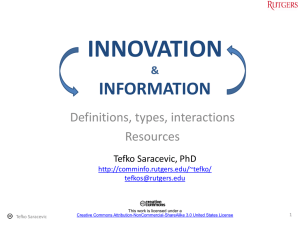IR traditional model
advertisement
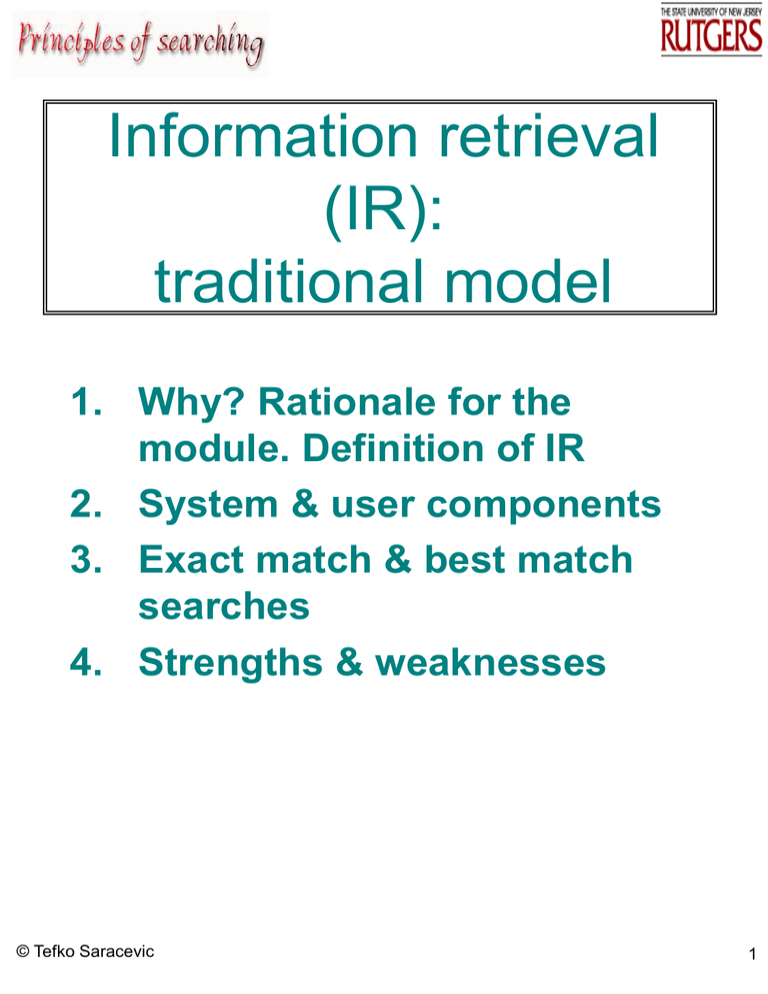
Information retrieval (IR): traditional model 1. Why? Rationale for the module. Definition of IR 2. System & user components 3. Exact match & best match searches 4. Strengths & weaknesses © Tefko Saracevic 1 1. Why? Rationale for the module. Definition of IR includes problems addressed in IR © Tefko Saracevic 2 Why? • Every online database, every search engine, everything that is searched online is based in some way or another on principles developed in IR – IR is at the heart of searching used in systems such as DIALOG, LexisNexis & others • Understanding the basics of IR is a prerequisite for understanding how searching of online systems works. © Tefko Saracevic 3 You are asking: • What basic elements and processes are involved in IR? • What are the conceptual bases for searching? • How are these applied in practice? © Tefko Saracevic 4 IR: - original definition “Information retrieval embraces the intellectual aspects of the description of information and its specification for search, and also whatever systems, techniques, or machines are employed to carry out the operation.” Calvin Mooers, 1951 © Tefko Saracevic 5 IR: Objective & problems Provide the users with effective access to & interaction with information resources. Problems addressed: 1. How to organize information intellectually? 2. How to specify search & interaction intellectually? 3. What systems & techniques to use for those processes? Where do you fit? With what problems do you deal? © Tefko Saracevic 6 2. System & user components Traditional IR model presented © Tefko Saracevic 7 IR models • Model depicts, represents what is involved – a choice of features, processes, things for consideration • Several IR models used over time – traditional: oldest, most used, shows basic elements involved treated in this module – interactive: more realistic, favored now, shows also interactions involved treated in next module (module 5) – Each has strengths, weaknesses © Tefko Saracevic 8 Description of traditional IR model • It has two streams of activities – one is the systems side with processes performed by the system – other is the user side with processes performed by users & intermediaries (you) – these two sides led to “system orientation” & “user orientation” – in system side automatic processing is done; in user side human processing is done • They meet at the matching process – where the query is fed into the system and system looks for documents that match the query • Also feedback is involved so that things change based on results – e.g. query is modified & new matching done © Tefko Saracevic 9 Traditional IR model User Acquisition Problem documents, objects information need Representation Representation indexing, ... question File organization Query indexed documents search formulation Matching searching feedback System Retrieved objects © Tefko Saracevic 10 Acquisition (system) • Content: What is in files, resources – in DIALOG first part of blue sheets: File Description, Subject Coverage • Selection of documents & other objects from various sources – in blue sheets: Sources • Mostly text based documents – full texts, titles, abstracts ... – but also other objects: data, statistics, images, maps, trade marks, sounds ... Importance: Determines contents – what is in it Key to file, resource selection !!! © Tefko Saracevic 11 Representation of documents, objects (system) • Indexing – many ways : – free text terms (even in full texts) – controlled vocabulary - thesaurus – manual & automatic techniques • Abstracting; summarizing • Bibliographic description: – author, title, sources, date… – metadata • Classifying, clustering • Organizing in fields & limits – in DIALOG: Basic Index, Additional Index. Limits Basic to what is available for searching & displaying © Tefko Saracevic 12 File organization (system) • Sequential – record (document) by record • Inverted – term by term; list of records under each term • Combination: indexes inverted, documents sequential • When citation retrieved only, need for document files • Large file approaches – for efficient retrieval by computers Enables searching & interplay between types of files © Tefko Saracevic 13 Problem (user) • Related to user’s task, situation – vary in specificity, clarity • Produces information need – ultimate criterion for effectiveness of retrieval how well was the need met? • Inf. need for the same problem may change, evolve, shift during the IR process - adjustment in searching – often more than one search for same problem over time you will experience this in your term project Critical for examination in interview © Tefko Saracevic 14 Representation - question ( user & possibly system) • Non-mediated: end user alone • Mediated: intermediary + user – interviews; human-human interaction • Question analysis – selection, elaboration of terms – various tools may be used thesaurus, classification schemes, dictionaries, textbooks, catalogs … • Focus toward – deriving search terms & logic – selection of files, resources • Subject to feedback changes • Critical roles of intermediary - you Determines search specification - a dynamic process © Tefko Saracevic 15 Query - search statement (user & system) • Translation into systems requirements & limits – start of human-computer interaction query is the thing that goes into the computer • Selection of files, resources • Search strategy - selection of: – – – – search terms & logic possible fields, delimiters controlled & uncontrolled vocabulary variations in effectiveness tactics • Reiterations from feedback – several feedback types: relevance feedback, magnitude feedback *... – query expansion & modification What & how of actual searching © Tefko Saracevic 16 Clarifying difference • Question is what user asks and what you may then have elaborated • Query is what is asked of computer to match – what is put in • Question is transformed into query • Question: – I am interested in major historical developments in the area of information retrieval? • Query – history information retrieval (in Google) – history AND information(w)retrieval (in DIALOG) (plus you have to select which file(s) to search) © Tefko Saracevic 17 Matching - searching (user & system) • Process of matching, comparing – search: what documents in the file match the query as stated? • Various search algorithms: – exact match - Boolean still available in most, if not all systems – best match - ranking by relevance increasingly used e.g. on the web – hybrids incorporating both e.g. Target, Rank in DIALOG • Each has strengths, weaknesses – no ‘perfect’ method exists and probably never will Involves many types of search interactions & formulations © Tefko Saracevic 18 Retrieved documents (from system to user) • Various order of output: – Last In First Out (LIFO); sorted – ranked by relevance – ranked by other characteristics • Various forms of output – In DIALOG: Output options • When citations only: possible links to document delivery • Base for relevance, utility evaluation by users • Relevance feedback What a user (or you) sees, gets, judges – can be specified © Tefko Saracevic 19 3. Exact match & best match searches Getting to that Boolean and similar stuff – the nitty-gritty of matching which actually affects how you formulate the query © Tefko Saracevic 20 Exact match Boolean search • You retrieve exactly what you ask for in the query: – all documents that have the term(s) with logical connection(s), and possible other restrictions (e.g. to be in titles) as stated in the query – exactly: nothing less, nothing more • Based on matching following rules of Boolean algebra, or algebra of sets – ‘new algebra’ – presented by circles in Venn diagrams © Tefko Saracevic 21 Boolean algebra • Operates on sets • – e.g. set of documents Has four operations (like in algebra): 1. A: retrieve set A I want documents that have the term library 2. A AND B: retrieve set that has A and B often called intersection & labeled A B I want documents that have both terms library and digital someplace within 3. A OR B: retrieve set that has either A or B often called union and labeled A B I want documents that have either term library or term digital someplace within 4. A NOT B: retrieve set A but not B often called negation and labeled A – B I want documents that have term library but if they also have term digital I do not want those © Tefko Saracevic 22 Potential problems • But beware: – digital AND library will retrieve documents that have digital library (together as a phrase) but also documents that have digital in the first paragraph and library in the third section, 5 pages later, and it does not deal with digital libraries at all – thus in Google you will ask for “digital library” and in DIALOG for digital(w)library to retrieve the exact phrase digital library – digital NOT library will retrieve documents that have digital and suppress those that along with digital also have library, but sometimes those suppressed may very well be relevant. Thus, NOT is also known as the “dangerous operator “ © Tefko Saracevic 23 Boolean algebra depicted in Venn diagrams Four basic operations: e.g. A = digital B= libraries A 1 B 2 A 3 A alone. All documents that have A. Shade 1 & 2. digital B 1 2 3 A AND B. Shade 2 digital AND libraies A B 1 2 3 A OR B. Shade 1, 2, 3 digital OR libraries A B 1 2 3 A NOT B. Shade 1 digital NOT libraries © Tefko Saracevic 24 Venn diagrams … cont. Complex statements allowed e.g A B 2 3 1 4 5 7 (A OR B) AND C Shade 4,5,6 6 (digital OR libraries) AND Rutgers C (A OR B) NOT C Shade what? (digital OR libraries) NOT Rutgers © Tefko Saracevic 25 Venn diagrams cont. • Complex statements can be made – as in ordinary algebra e.g. (2+3)x4 • As in ordinary algebra: watch for parenthesis: – 2+(3 x 4) is not the same as (2+3)x4 – (A AND B) OR C is not the same as A AND (B OR C) © Tefko Saracevic 26 Best match searching • Output is ranked – it is NOT presented as a Boolean set but in some rank order • You retrieve documents ranked by how similar (close) they are to a query (as calculated by the system) – similarity assumed as relevance – ranked from highest to lowest relevance to the query mind you, as considered by the system you change the query, system changes rank – thus, documents as answers are presented from those that are most likely relevant downwards to less & less likely relevant – can be cut at any desired number - e.g. first 10 © Tefko Saracevic 27 Best match ... cont. • Best match process deals with PROBABILITY: – compares the set of query terms with the sets of terms in documents – calculates a similarity between query & each document based on common terms &/or other aspects – sorts the documents in order of similarity – assumes that the higher ranked documents have a higher probability of being relevant – allows for cut-off at a chosen number • BIG issue: What representation & similarity measures are better? – “better” determined by a number of criteria, e.g. relevance, speed … © Tefko Saracevic 28 Best match (cont.) • Variety of algorithms (formulas) used to determine similarity – using statistic &/or linguistic properties e.g. if digital appears a lot in a given document relative to its size, that document will be ranked higher when the query is digital – many proposed & tested in IR research – many developed by commercial organizations Google also uses calculations as to number of links to/from a document many algorithms are now proprietary – system ranking and your ranking may not necessarily be in agreement • Web outputs are mostly ranked • But DIALOG allows ranking as well, with special commands © Tefko Saracevic 29 4. Strengths & weaknesses © Tefko Saracevic 30 Boolean vs. best match • Boolean – allows for logic – provides all that has been matched BUT – has no particular order of output – treats all retrievals equally - from the most to least relevant ones – often requires examination of large outputs • Best match – allows for free terminology – provides for a ranked output – provides for cutoff - any size output BUT – does not include logic – ranking method (algorithm) not transparent whose relevance? – where to cut off? © Tefko Saracevic 31 Strengths of traditional IR model • Lists major components in both system & user branches • Suggests: – What to explain to users about system, if needed – What to ask of users for more effective searching (problem ...) • Selection of component(s) for concentration – mostly ever better representation • Provides a framework for evaluation of (static) aspects © Tefko Saracevic 32 Weaknesses • Does not address nor account for interaction & judgment of results by users – identifies interaction with search only – interaction is a much richer process • Many types of & variables in interaction not reflected • Feedback has many types & functions - also not shown • Evaluation thus one-sided IR is a highly interactive process - thus additional model(s) needed © Tefko Saracevic 33 Interactive models • Explored in next module Module 5 © Tefko Saracevic 34
